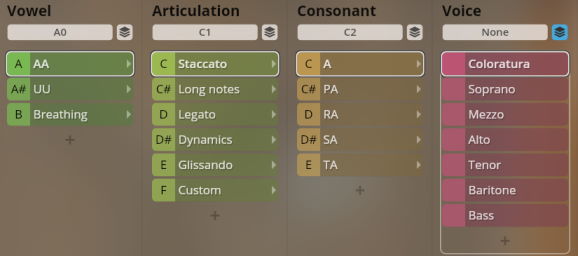previously "SYNCHRON-ized Solo Voices"
Studio Solo Voices is based on its Vienna Instruments counterpart, and offers a completely overhauled sample database optimized for the Vienna Synchron Player. Our goal was to improve each instrument’s playability and realism even more, which we achieved by enhancing the sample recordings as well as by utilizing the Synchron Player’s unique features.
Recording the human voice as the oldest and most expressive musical instrument ever is a special challenge and to make it “playable” as an intuitive virtual instrument requires even higher demands. That’s why only the best singers with a special focus on a homogeneous timbre over the full register were selected, featuring four female voices (coloratura soprano, soprano, mezzo soprano, alto) and three male voices (tenor, baritone, bass). Countless hours were spent performing with utmost perfection regarding tone, intonation and consistency. Every recorded note is a testament to the professionalism of these outstanding artists. This collection allows for an accurate and authentic realization of polyphonic vocal repertoire – both as an a cappella performance or in various other instrumental combinations.
Voices
- coloratura soprano
- soprano
- mezzo-soprano
- alto
- tenor
- bariton
- bass
Special Preset
- double quartet
Articulations
- staccato
- long notes
- legato
- dynamics
- glissando
All articulations are available on the vowels “AA” and “UU”. In addition, there is a special “Breathing” patch.
If parallel mode in the first dimension is enabled, it is possible to switch between AA and UU vowels in the middle of notes. In addition, the breathing noises can be added without an articulation switch. However, you should be aware that twice as many voices will be streamed, so that using this option will take much more performance.
- Ranges
- Coloratura soprano F4–F6
- Soprano C4–D6
- Mezzo-soprano A3–C6
- Alto F3–A5
- Tenor C3–D5
- Baritone G2–A4
- Bass C2–E4
The range of up and down glissandos is an octave less (in the glissando direction) than the full voice range.
- Breathing sounds are mapped on white keys from C7 to C8
- Vowel / breathing keyswitches: A0–B0.
- Articulation keyswitches: C1–F#1.
Staccato on “aa”, “pa”, “ra”, “sa”, “ta” / “uu”, “pu”, “ru”, “su”, “tu”.
Vowels and Consonants: C2–E2, C5–E5 (baritone, basses).
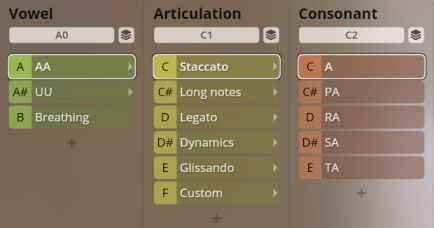
Long notes normal and with marcato attack on vowels and consonants.
- Normal/marcato: G1/G#1
- Vowels and consonants: C2–E2 / C5–E5 (baritone, bass)
- Marcato attack: Dim.Ctrl/A (keystroke velocity)
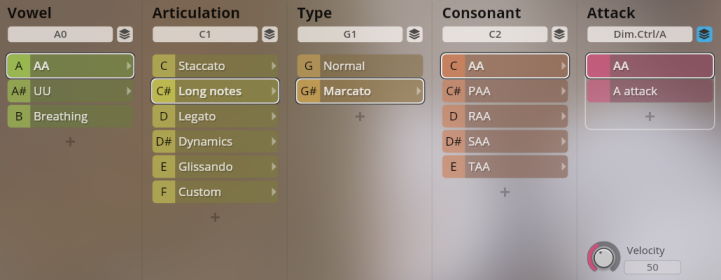
Legato normal and with marcato attack on vowels and consonants, as well as Performance trills.
- Normal/marcato: G1/G#1.
- Vowels and consonants: C2–E2 / C5–E5 (baritone, bass)
- Marcato attack: Dim.Ctrl/A (keystroke velocity)
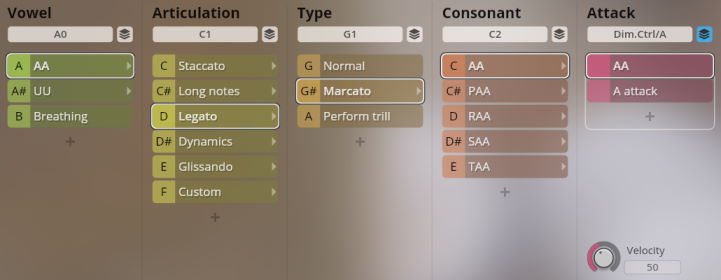
Sforzato, crescendo and diminuendo 2/4 seconds, and crescendo with marcato attack on vowels and consonants.
- Dynamics type: G1–A1
- Length switches: F2/G2, F5/G5
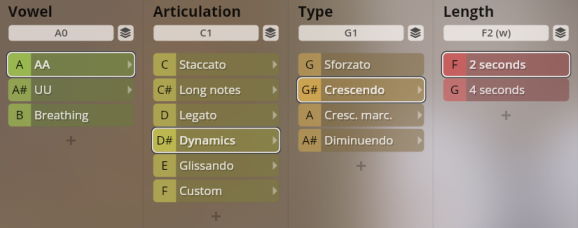
Keystroke velocity determines the marcato attack amount.
- Vowels and consonants: C2–E2 / C5–E5 (baritone, basses).
- Marcato attack: Dim.Ctrl/A (keystroke velocity).
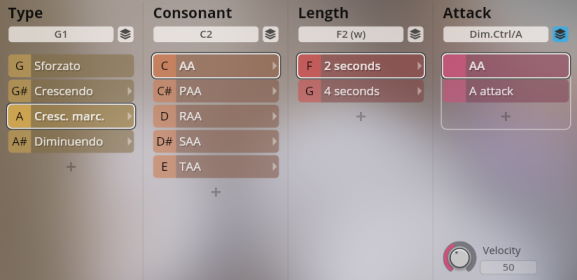
Octave glissandos up and down.
- Glissando up/down: G1/G#1.
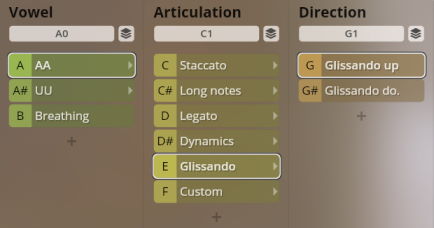
The “Double quartet” Preset features a stacked layer of individual voices. This can be especially useful, e.g., for quick sketches.
- Range: F2–D6; glissando up F2–D5; glissando down F3–D6.
